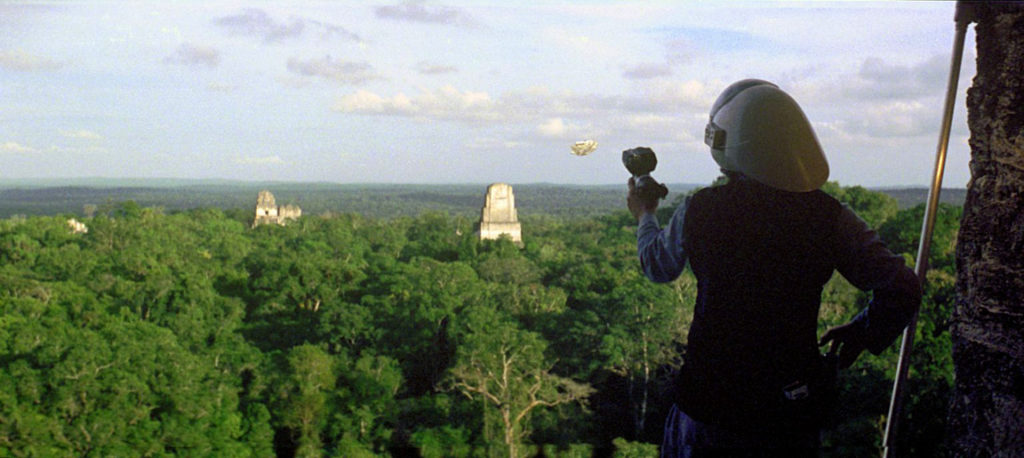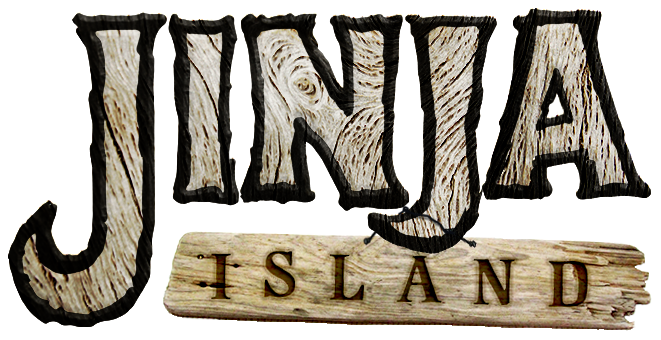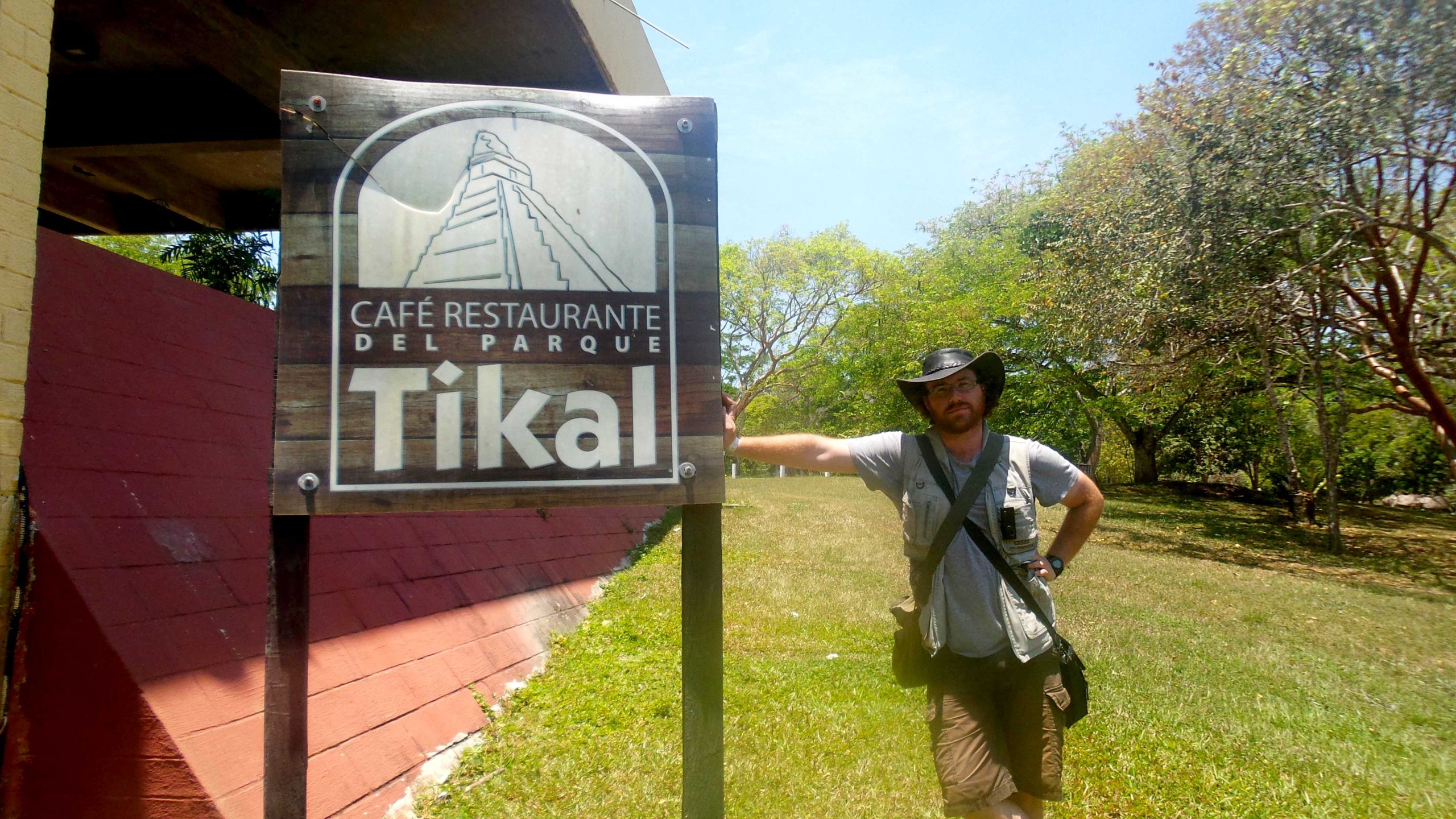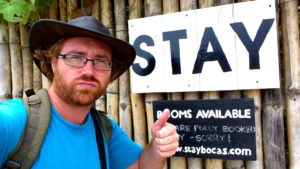Tuesday 22st – Thursday 24th April 2014



Eventually, the minibus that was taking us to Flores rucked up and after five minutes on the only road in or out of this one horse bordertown I saw why it was so late – yeah, we was bumpin’ and grindin’ down the old gravel n’ dust highway.

After a few hours of being bounced around like your mum last Saturday night, we hit good solid asphalt HUZZAH!! We arrived in the wonderful little town of Flores around mid-afternoon.

The town of Flores is situated on an island on lake Petén Itzá, the second largest lake in Guatemala… and it couldn’t be more pleasant if it tried.

That afternoon we chilled on hammocks on the roof of our backpackers and in the evening we enjoyed a delicious meal in a homely little place that overlooked the lake.

With our receipt, we were given these teeny-tiny Guatemalan “worry dolls” – apparently, if you’re having trouble sleeping, you tell them what’s keeping you awake and then place them under your pillow. They’ll take your worries away and allow you to sleep. Aww… I love this place!

After all of the previous day’s excitement, we decided that we wouldn’t rush to Tikal the next day, but would instead spend the day hanging out in this awesome little town. I could stay here for a long, long time.

So it was the morning of Thursday April 24 2014 before we headed to the crown jewel of the Mayan empire… TIKAL.
Mayan Site #10: Tikal
We left at 4am in order to see the sunrise from the top of Temple IV, something of a rite of passage for touristy tourists such as ourselves. It takes about an hour to get to the site from Flores, and when we arrived it sunrise was still a good hour away.

Before we entered the site proper, we were shown a 3-D model of the city, to help get our bearings. Not that we’d be going anywhere at night without a guide.

We trekked to Temple IV in the dark – it seemed like our minibus gang were the only people there.

Casey is afraid of heights and had problems scrambling up some of the pyramids along on the Ruta Maya, but she plucked up the courage to climb Temple IV – the tallest temple in the entire Mayan world. She did herself proud. A few months later she would do her first skydive.

All night the sky was as clear as an unmuddied lake, however, as dawn broke over the jungle a heavy mist rose from the canopy, obscuring what would otherwise have been a spectacular sunrise.


Tikal is located in the archaeological region of the Petén Basin in what is now northern Guatemala. Because of the site’s remoteness from modern towns, however, no explorers visited Tikal until Modesto Méndez and Ambrosio Tut, respectively the commissioner and the governor of Petén, visited it in 1848. Tut reported a set of mysterious ruins to a La Gaceta, a Guatemalan newspaper, which named the site Tikal (Tik’al in modern Mayan orthography). In 1853, the report was published in the Berlin Academy of Sciences’ Magazine and archaeologists and treasure hunters flooded in.

Tikal was one of the largest of the Classic period Maya cities and was one of the largest cities in the Americas. The architecture of the ancient city is built from limestone and includes the remains of temples that tower over 70 metres (230 ft) high, large royal palaces, in addition to a number of smaller pyramids, palaces, residences, administrative buildings, platforms and inscribed stone monuments. There is even a building which seemed to have been a jail, originally with wooden bars across the windows and doors. There are also seven courts for playing the Mesoamerican ballgame, including a set of 3 in the Seven Temples Plaza, a unique feature in Mesoamerica.

Tikal was the capital of a conquest state that became one of the most powerful kingdoms of the ancient Maya. Though monumental architecture at the site dates back as far as the 4th century BC, Tikal reached its apogee during the Classic Period, ca. 200 to 900 AD. During this time, the city dominated much of the Maya region politically, economically, and militarily, while interacting with areas throughout Mesoamerica such as the great metropolis of Teotihuacan in the distant Valley of Mexico.

Tikal is the best understood of any of the large lowland Maya cities, with a long dynastic ruler list, the discovery of the tombs of many of the rulers on this list and the investigation of their monuments, temples and palaces.

The name Tikal may be derived from ti ak’al in the Yucatec Maya language; it is said to be a relatively modern name meaning “at the waterhole”. The name was apparently applied to one of the site’s ancient reservoirs by hunters and travellers in the region. It has alternatively been interpreted as meaning “the place of the voices” in the Itza Maya language. Tikal, however, is not the ancient name for the site but rather the name adopted shortly after its discovery in the 1840s. Hieroglyphic inscriptions at the ruins refer to the ancient city as Yax Mutal or Yax Mutul, meaning “First Mutal”. Tikal may have come to have been called this because Dos Pilas also came to use the same emblem glyph; the rulers of the city presumably wanted to distinguish themselves as the first city to bear the name.

Tikal is located 19 kilometres (12 mi) south of the contemporary Maya city of Uaxactun and 30 kilometres (19 mi) northwest of Yaxha. The city was located 100 kilometres (62 mi) southeast of its great Classic Period rival, Calakmul, and 85 kilometres (53 mi) northwest of Calakmul’s ally Caracol, now in Belize.

The city once covered an area greater than 16 square kilometres (6.2 sq mi) and included about 3,000 structures. The area around Tikal has been declared as the Tikal National Park and the preserved area covers 570 square kilometres (220 sq mi).

The ruins lie among the tropical rainforests of northern Guatemala that formed the cradle of lowland Maya civilization. The city itself was located among abundant fertile upland soils, and may have dominated a natural east—west trade route across the Yucatan Peninsula. For centuries the city was completely covered under jungle.

There are traces of early agriculture at the site dating as far back as 1000 BC, in the Middle Preclassic. A cache of Mamon ceramics dating from about 700-400 BC were found in a sealed chultun, a subterranean bottle-shaped chamber.

Major construction at Tikal was already taking place in the Late Preclassic period, first appearing around 400–300 BC, including the building of major pyramids and platforms, although the city was still dwarfed by sites further north such as El Mirador and Nakbe. At this time, Tikal participated in the widespread Chikanel culture that dominated the Central and Northern Maya areas at this time – a region that included the entire Yucatan Peninsula including northern and eastern Guatemala and all of Belize.

In the 1st century AD rich burials first appeared and Tikal underwent a political and cultural florescence as its giant northern neighbours declined. After being conquered by Teotihuacan in 378 AD, Tikal rapidly rose to dominate the northern and eastern Peten. Uaxactun, together with smaller towns in the region, were absorbed into Tikal’s kingdom. Other sites, such as Bejucal and Motul de San José near Lake Petén Itzá became vassals of their more powerful neighbor to the north. By the middle of the 5th century Tikal had a core territory of at least 25 kilometres (16 mi) in every direction.

In the 5th century the power of the city reached as far south as Copán (where we’re heading next), whose founder K’inich Yax K’uk’ Mo’ was clearly connected with Tikal. Copán itself was not in an ethnically Maya region and the founding of the Copán dynasty probably involved the direct intervention of Tikal.

A long-running rivalry between Tikal and Calakmul began in the 6th century, with each of the two cities forming its own network of mutually hostile alliances arrayed against each other in what has been likened to a long-running war between two Maya superpowers. The kings of these two capitals adopted the title kaloomte’, a term that has not been precisely translated but that implies something akin to “high king”.

In the mid 6th century, Caracol seems to have allied with Calakmul and defeated Tikal, closing the Early Classic, a defeat that seems to have resulted in the capture and sacrifice of the king of Tikal. The badly eroded Altar 21 at Caracol described how Tikal suffered this disastrous defeat in a major war in April 562. Tikal was not sacked but its power and influence were broken. Thus began the Tikal hiatus, which has served as a marker by which archaeologists commonly subdivide the Classic period of Mesoamerican chronology into the Early and Late Classic.

By the 9th century, the crisis of the Classic Maya collapse was sweeping across the region, with populations plummeting and city after city falling into silence. Increasingly endemic warfare in the Maya region caused Tikal’s supporting population to heavily concentrate close to the city itself, accelerating the use of intensive agriculture and corresponding environmental decline.

In the latter half of the 9th century there was an attempt to revive royal power at the much diminished city of Tikal, as evidenced by a stela erected in the Great Plaza by Jasaw Chan K’awiil II in 869. This was the last monument erected at Tikal before the city finally fell into silence. The former satellites of Tikal, such as Jimbal and Uaxactun, did not last much longer, erecting their final monuments in 889. By the end of the 9th century the vast majority of Tikal’s population had deserted the city, its royal palaces were occupied by squatters and simple thatched dwellings were being erected in the city’s ceremonial plazas.

Before its final abandonment all respect for the old rulers had disappeared, with the tombs of the North Acropolis being explored for jade and the easier to find tombs being looted. After 950, Tikal was all but deserted and the rainforest claimed the ruins for the next thousand years.

In 1525, the Spanish conquistador Hernán Cortés passed within a few kilometres of the ruins of Tikal but did not mention them in his letters. After Spanish friar Andrés de Avendaño became lost in the Petén forests in early 1696 he described a ruin that may well have been Tikal, but it wasn’t until the 1850s that Mr. Tut and would reintroduce Tikal to the world.

Pioneering archaeologists started to clear, map and record the ruins in the 1880s. In 1951, a small airstrip was built at the ruins, which previously could only be reached by several days’ travel through the jungle on foot or mule. In 1956 the Tikal project began to map the city on a scale not previously seen in the Maya area. From 1956 through 1970, major archaeological excavations were carried out by the University of Pennsylvania Tikal Project. They mapped much of the site and excavated and restored many of the structures.

There are thousands of ancient structures at Tikal and only a fraction of these have been excavated, after decades of archaeological work. The most prominent surviving buildings include six very large pyramids, labelled Temples I – VI, each of which support a temple structure on their summits. Some of these pyramids are over 60 metres high (200 feet). They were numbered sequentially during the early survey of the site. It is estimated that each of these major temples could have been built in as little as two years.

Temple I (also known as the Temple of Ah Cacao or Temple of the Great Jaguar) is a funerary pyramid dedicated to Jasaw Chan K’awil, who was entombed in the structure in AD 734, the pyramid was completed around 740–750. The temple rises 47 metres (154 ft) high. The massive roofcomb that topped the temple was originally decorated with a giant sculpture of the enthroned king, although little of this decoration survives. The tomb of the king was discovered by Aubrey Trik of the University of Pennsylvania in 1962. Among items recovered from the Late Classic tomb were a large collection of inscribed human and animal bone tubes and strips with sophisticated scenes depicting deities and people, finely carved and rubbed with vermilion, as well as jade and shell ornaments and ceramic vessels filled with offerings of food and drink. The shrine at the summit of the pyramid has three chambers, each behind the next, with the doorways spanned by wooden lintels fashioned from multiple beams. The outermost lintel is plain but the two inner lintels were carved, some of the beams were removed in the 19th century and their location is unknown, while others were taken to museums in Europe.

Temple II (also known as the Temple of the Mask) in was built around AD 700 and stands 38 metres (125 ft) high. Like other major temples at Tikal, the summit shrine had three consecutive chambers with the doorways spanned by wooden lintels, only the middle of which was carved. The temple was dedicated to the wife of Jasaw Chan K’awil, although no tomb was found. The queen’s portrait was carved into the lintel spanning the doorway of the summit shrine. One of the beams from this lintel is now in the American Museum of Natural History in New York.

Temple III (also known as the Temple of the Jaguar Priest) was the last of the great pyramids to be built at Tikal. It stood 55 metres (180 ft) tall and contained an elaborately sculpted but damaged roof lintel, possibly showing Dark Sun engaged in a ritual dance around AD 810. The temple shrine possesses two chambers.

Temple IV marks the reign of Yik’in Chan Kawil (Ruler B, the son of Ruler A or Jasaw Chan K’awiil I) and two carved wooden lintels over the doorway that leads into the temple on the pyramid’s summit record a long count date (9.15.10.0.0) that corresponds to 741AD. Temple IV is the largest pyramid built anywhere in the Maya region in the 8th century and as it currently stands is the tallest pre-Columbian structure in the Americas although the Pyramid of the Sun at Teotihuacan may originally have been taller, as may have been one of the structures at El Mirador.

Temple V stands south of the Central Acropolis and is the mortuary pyramid of an as yet unidentified ruler. The temple stands 57 metres (187 ft) high, making it the second tallest structure at Tikal – only Temple IV is taller. The temple has been dated to about AD 700, in the Late Classic period, via radiocarbon analysis and the dating of ceramics associated with the structure places its construction during the reign of Nun Bak Chak in the second half of the 7th century.

Temple VI is also known as the Temple of the Inscriptions and was dedicated in AD 766. It is notable for its 12-metre (39 ft) high roof-comb. Panels of hieroglyphs cover the back and sides of the roof-comb. The temple faces onto a plaza to the west and its front is unrestored.

Temple 33 was a funerary pyramid erected over the tomb of Siyaj Chan K’awiil I (known as Burial 48) in the North Acropolis. It started life in the Early Classic as a wide basal platform decorated with large stucco masks that flanked the stairway. Later in the Early Classic a new superstructure was added, with its own masks and decorated panels. During the Hiatus a third stage was built over the earlier constructions, the stairway was demolished and another royal burial, of an unidentified ruler, was set into the structure (Burial 23). While the new pyramid was being built another high ranking tomb (Burial 24) was inserted into the rubble core of the building. The pyramid was then completed, standing 33 metres (108 ft) tall. The final version of Temple 33 was completely dismantled by archaeologists in 1965 in order to arrive at the earlier stages of construction. WHAT??? Really?!!

Temple 34 is a pyramid in the North Acropolis that was built by Siyaj Chan K’awiil II over the tomb of his father, Yax Nuun Ayiin I. The pyramid was topped by a three chambered shrine, the rooms situated one behind the other.

Structure 5D-43 is an unusual radial temple in the East Plaza, built over a pre-existing twin pyramid complex. It is built into the end of the East Plaza Ballcourt and possessed four entry doorways and three stairways, the fourth (south) side was too close to the Central Acropolis for a stairway on that side. The building has a talud-tablero platform profile, modified from the original style found at Teotihuacan. The vertical tablero panels are set between sloping talud panels and are decorated with paired disc symbols. Large flower symbols are set into the sloping talud panels, related to the Venus and star symbols used at Teotihuacan.

Structure 5C-49 possesses a clear Teotihuacan-linked architectural style; it has balustrades, an architectural feature that is very rare in the Maya region, and a talud-tablero façade; it dates to the 4th century AD. It is located near to the Lost World pyramid.

The Lost World Pyramid (Structure 5C-54) is the largest structure in the Mundo Perdido complex. It was decorated with stucco masks of the sun god and dates to the Late Preclassic; this pyramid is part of an enclosed complex of structures that remained intact and un-impacted by later building activity at Tikal. By the end of the Late Preclassic this pyramid was one of the largest structures in the Maya region. It attained its final form during the reign of Chak Tok Ich’aak in the 4th century AD, in the Early Classic, standing more than 30 metres (98 ft) high with stairways on all four sides and a flat top that possibly supported a superstructure built from perishable materials.

Phew!!! Of course there’s loads more to explore, but I think that’ll do for now. Just a couple things left to tell you about Tikal. First up, the place was used in the original Star Wars movie as Yavin IV…

And the gigantic kapok (Ceiba pentandra) that grows here inspired James Cameron’s “Tree of Life” concept in Avatar.

After a long day we took a bus back to Flores just in time to swim in the lake before it got dark. After our last lovely meal in Flores, we crossed the causeway back to the “mainland” and began our long journey south to Honduras and Copan Ruinas – the last stop on our Ruta Maya.






